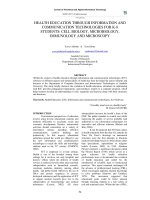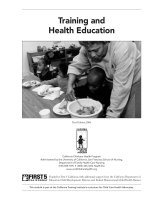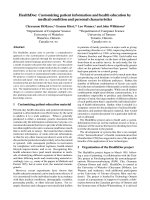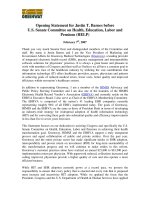HEALTH BEHAVIOR AND HEALTH EDUCATION: Theory, Research, and Practice pdf
Bạn đang xem bản rút gọn của tài liệu. Xem và tải ngay bản đầy đủ của tài liệu tại đây (3.3 MB, 590 trang )
HEALTH
BEHAVIOR
AND
HEALTH
EDUCATION
Theory, Research,
and Practice
4TH EDITION
KAREN GLANZ
BARBARA K. RIMER
K. VISWANATH
Editors
Foreword by C. Tracy Orleans
Glanz.ffirs 7/2/08 11:22 AM Page iii
Glanz.ffirs 7/2/08 11:22 AM Page ii
HEALTH
BEHAVIOR
AND
HEALTH
EDUCATION
Glanz.ffirs 7/2/08 11:22 AM Page i
Glanz.ffirs 7/2/08 11:22 AM Page ii
HEALTH
BEHAVIOR
AND
HEALTH
EDUCATION
Theory, Research,
and Practice
4TH EDITION
KAREN GLANZ
BARBARA K. RIMER
K. VISWANATH
Editors
Foreword by C. Tracy Orleans
Glanz.ffirs 7/2/08 11:22 AM Page iii
Copyright © 2008 by John Wiley & Sons, Inc. All rights reserved.
Published by Jossey-Bass
A Wiley Imprint
989 Market Street, San Francisco, CA 94103-1741—www.josseybass.com
No part of this publication may be reproduced, stored in a retrieval system, or transmitted in any form
or by any means, electronic, mechanical, photocopying, recording, scanning, or otherwise, except as
permitted under Section 107 or 108 of the 1976 United States Copyright Act, without either the prior
written permission of the publisher, or authorization through payment of the appropriate per-copy fee
to the Copyright Clearance Center, Inc., 222 Rosewood Drive, Danvers, MA 01923, 978-750-8400,
fax 978-646-8600, or on the Web at www.copyright.com. Requests to the publisher for permission
should be addressed to the Permissions Department, John Wiley & Sons, Inc., 111 River Street,
Hoboken, NJ 07030, 201-748-6011, fax 201-748-6008, or online at www. wiley.com/go/permissions.
Readers should be aware that Internet Web sites offered as citations and/or sources for further infor-
mation may have changed or disappeared between the time this was written and when it is read. Limit
of Liability/Disclaimer of Warranty: While the publisher and author have used their best efforts in
preparing this book, they make no representations or warranties with respect to the accuracy or com-
pleteness of the contents of this book and specifi cally disclaim any implied warranties of merchant-
ability or fi tness for a particular purpose. No warranty may be created or extended by sales represen-
tatives or written sales materials. The advice and strategies contained herein may not be suitable for
your situation. You should consult with a professional where appropriate. Neither the publisher nor
author shall be liable for any loss of profi t or any other commercial damages, including but not limited
to special, incidental, consequential, or other damages.
Jossey-Bass books and products are available through most bookstores. To contact Jossey-Bass
directly call our Customer Care Department within the U.S. at 800-956-7739, outside the U.S. at
317-572-3986, or fax 317-572-4002. Jossey-Bass also publishes its books in a variety of electronic
formats. Some content that appears in print may not be available in electronic books.
Library of Congress Cataloging-in-Publication Data
Health behavior and health education : theory, research, and practice / Karen Glanz, Barbara K.
Rimer, and K. Viswanath, editors. — 4th ed.
p. ; cm.
Includes bibliographical references and index.
ISBN 978-0-7879-9614-7 (cloth)
1. Health behavior. 2. Health education. 3. Health promotion. I. Glanz, Karen. II. Rimer, Barbara K.
III. Viswanath, K. (Kasisomayajula)
[DNLM: 1. Health Behavior. 2. Health Education. W 85 H43415 2008]
RA776.9.H434 2008
613—dc22
2008021038
Printed in the United States of America
FOURTH EDITION
HB Printing 10987654321
Glanz.ffirs 7/2/08 11:22 AM Page iv
CONTENTS
Foreword xiii
C. Tracy Orleans
Tables and Figures xvii
Preface xxi
The Editors xxvii
The Contributors xxxi
PART ONE: HEALTH EDUCATION AND
HEALTH BEHAVIOR: THE FOUNDATIONS 1
ONE: THE SCOPE OF HEALTH BEHAVIOR
AND HEALTH EDUCATION 3
The Editors
Key Points 3
The Changing Context of Health Behavior 6
Health Education and Health Behavior in Context 9
Settings and Audiences for Health Education 12
Progress in Health Promotion and Health Behavior Research 16
Summary 18
TWO: THEORY, RESEARCH, AND PRACTICE
IN HEALTH BEHAVIOR AND HEALTH EDUCATION 23
The Editors
Key Points 23
Theory, Research, and Practice: Interrelations 24
What Is Theory? 26
Paradigms for Theory and Research in Health Promotion and Education 29
Trends in Use of Health Behavior Theories and Models 31
Selection of Theories for This Book 33
Fitting a Theory or Theories to Research and Practice 35
Limitations of This Book 37
Summary 38
Glanz.ftoc 7/2/08 11:23 AM Page v
vi Contents
PART TWO: MODELS OF INDIVIDUAL HEALTH BEHAVIOR 41
Barbara K. Rimer
THREE: THE HEALTH BELIEF MODEL 45
Victoria L. Champion and Celette Sugg Skinner
Key Points 45
Origins of the Model 46
Description of HBM and Key Constructs 46
Evidence for the Model’s Performance 50
Measurement of HBM Constructs 51
Applications of the HBM to Mammography
and AIDS-Related Behaviors 53
Comparison of HBM to Other Theories 60
Challenges in Future HBM Research 61
Summary 62
FOUR: THEORY OF REASONED ACTION, THEORY OF PLANNED
BEHAVIOR, AND THE INTEGRATED BEHAVIORAL MODEL 67
Daniel E. Montaño and Danuta Kasprzyk
Key Points 67
Origins and Historical Development 68
Theory of Reasoned Action and Theory of Planned Behavior 70
An Integrated Behavioral Model 77
Elicitation 82
Application of IBM to HIV Prevention in Zimbabwe 82
Summary 92
FIVE: THE TRANSTHEORETICAL MODEL
AND STAGES OF CHANGE 97
James O. Prochaska, Colleen A. Redding, and Kerry E. Evers
Key Points 97
Core Constructs 98
Applications of the Transtheoretical Model 108
Multiple-Behavior Change Programs 114
Limitations of the Model 116
Future Research 116
Summary 117
Glanz.ftoc 7/2/08 11:23 AM Page vi
Contents vii
SIX: THE PRECAUTION ADOPTION PROCESS MODEL 123
Neil D. Weinstein, Peter M. Sandman, and Susan J. Blalock
Key Points 123
How Stage Theories Address Explaining and Changing Behavior 124
The Precaution Adoption Process Model 126
Using the PAPM to Develop and Evaluate Behavior Change Interventions 131
How Stage Theories Can Be Tested 134
An Example Using Matched and Mismatched Treatments 134
Review of Research Using the PAPM 140
Criteria for Applying Stage-Based Interventions 143
Future Directions 145
Summary 145
SEVEN: PERSPECTIVES ON HEALTH BEHAVIOR
THEORIES THAT FOCUS ON INDIVIDUALS 149
Noel T. Brewer and Barbara K. Rimer
Key Points 149
Why Theory Is Needed 150
How to Decide Which Theory to Use 151
A Closer Look at Individual-Level Theories 152
Commonalities and Differences Across the Theories 157
New Constructs and Theories 160
Summary 162
PART THREE: MODELS OF INTERPERSONAL
HEALTH BEHAVIOR 167
EIGHT: HOW INDIVIDUALS, ENVIRONMENTS, AND HEALTH
BEHAVIORS INTERACT: SOCIAL COGNITIVE THEORY 169
Alfred L. McAlister, Cheryl L. Perry, and Guy S. Parcel
Key Points 169
Concepts of SCT 170
Applications to Health Promotion 175
Case Studies 178
New Applications 182
Limitations in Research on New SCT Applications 184
Summary 185
Glanz.ftoc 7/2/08 11:23 AM Page vii
viii Contents
NINE: SOCIAL NETWORKS AND SOCIAL SUPPORT 189
Catherine A. Heaney and Barbara A. Israel
Key Points 189
Definitions and Terminology 189
Background of the Concepts 192
Relationship of Social Networks and Social Support to Health 193
Empirical Evidence on the Influence of Social Relationships 195
Translating Theory and Research into Practice 197
Social Network and Social Support Interventions 199
Health Education and Health Behavior Applications 203
Future Directions for Research and Practice 206
Summary 207
TEN: STRESS, COPING, AND HEALTH BEHAVIOR 211
Karen Glanz and Marc D. Schwartz
Key Points 211
Historical Concepts of Health, Stress, and Coping 212
The Transactional Model of Stress and Coping: Overview,
Key Constructs, and Empirical Support 213
Theoretical Extensions 220
Applications to Specific Health Behavior Research Areas 226
Research Gaps and Future Directions 229
Summary 230
ELEVEN: KEY INTERPERSONAL FUNCTIONS AND HEALTH
OUTCOMES: LESSONS FROM THEORY AND RESEARCH ON
CLINICIAN-PATIENT COMMUNICATION 237
Richard L. Street Jr. and Ronald M. Epstein
Key Points 237
Communication Between Health Care Providers and Patients:
Historical Perspective 239
Pathways Between Clinician-Patient Communication
and Health Outcomes 239
Key Functions of Clinician-Patient Communication 245
Moderators of Communication-Outcome Relationships 255
Clinician-Patient Communication: Application in
Health Education and Health Behavior 261
Directions for Future Research
Summary 263
Glanz.ftoc 7/2/08 11:23 AM Page viii
Contents ix
TWELVE: PERSPECTIVES ON MODELS OF
INTERPERSONAL HEALTH BEHAVIOR 271
K. Viswanath
Key Points 271
Some Defining Characteristics of Interpersonal Interaction 272
Theories and Models at the Interpersonal Level 273
Summary and Future Directions 279
PART FOUR: COMMUNITY AND GROUP MODELS
OF HEALTH BEHAVIOR CHANGE 283
Karen Glanz
THIRTEEN: IMPROVING HEALTH THROUGH COMMUNITY
ORGANIZATION AND COMMUNITY BUILDING 287
Meredith Minkler, Nina Wallerstein, and Nance Wilson
Key Points 287
Historical Perspective 288
The Concept of Community 290
Models of Community Organization 291
Concepts in Community Organization and Community-Building Practice 293
Community Capacity and Social Capital 295
Issue Selection, Participation, and Relevance 296
Measurement and Evaluation Issues 298
Application of Community Organization and Community Building 300
Community Organizing and Community Building with Youth:
Challenges and Considerations 307
The Challenge of Community Organization Approaches 308
Summary 309
FOURTEEN: DIFFUSION OF INNOVATIONS 313
Brian Oldenburg and Karen Glanz
Key Points 313
Development of the Field and Related Research Traditions 314
Key Concepts 317
Important Factors in the Diffusion Process 319
The Role of Settings and Organizations in Diffusion
of Health Behavior Innovations 321
The Practice of Dissemination and Diffusion of Health
Behavior Interventions 322
Glanz.ftoc 7/2/08 11:23 AM Page ix
x Contents
Applications 323
Limitations of the Model and Challenges for the Future 328
Summary 330
FIFTEEN: MOBILIZING ORGANIZATIONS FOR HEALTH
PROMOTION: THEORIES OF ORGANIZATIONAL CHANGE 335
Frances Dunn Butterfoss, Michelle C. Kegler, and Vincent T. Francisco
Key Points 335
Introduction to Theories of Organizational Change 336
Change Within Organizations 338
Organizational Development Theory 341
Change Across Organizations 345
Applications of Organizational Theory to Health Promotion 350
Future Research to Inform Organizational Change Theories 355
Summary 357
SIXTEEN: COMMUNICATION THEORY AND HEALTH
BEHAVIOR CHANGE: THE MEDIA STUDIES FRAMEWORK 363
John R. Finnegan Jr. and K. Viswanath
Key Points 363
Organization of Communication Studies 364
Message Production and Media Effects 365
Major Models and Hypotheses at the Individual Level 367
Theories at the Macro Level 371
Planned Use of Media 379
Future Directions 382
Summary 384
SEVENTEEN: PERSPECTIVES ON GROUP, ORGANIZATION,
AND COMMUNITY INTERVENTIONS 389
Michelle C. Kegler and Karen Glanz
Key Points 389
New Concepts and Strategies for Macro-Level Change 390
Multiple Levels of Influence and Action 391
Models for Change 392
Approaches to Defining Needs, Problems, and Aims 395
The Influence of Technology on Macro-Level Theory and Practice 396
Similarities Between Models 397
Research Issues 399
Summary 400
Glanz.ftoc 7/2/08 11:23 AM Page x
Contents xi
PART FIVE: USING THEORY IN RESEARCH AND PRACTICE 405
EIGHTEEN: USING THE PRECEDE-PROCEED MODEL
TO APPLY HEALTH BEHAVIOR THEORIES 407
Andrea Carson Gielen, Eileen M. McDonald,
Tiffany L. Gary, and Lee R. Bone
Key Points 408
Overview of the PRECEDE-PROCEED Model 408
Issues to Consider in Using PRECEDE-PROCEED 417
Case Study: The SAFE Home Project 418
Case Study: Project Sugar 1 424
Summary 429
NINETEEN: SOCIAL MARKETING 435
J. Douglas Storey, Gary B. Saffitz, and Jose G. Rimón
Key Points 435
Definition of Social Marketing 436
Basic Principles of Social Marketing 439
The Role of Social Marketing Within a Strategic
Communication Framework 444
The Role of Theory and Research in Social Marketing 448
International and Domestic (U.S.) Social Marketing Experiences 452
Summary 461
TWENTY: ECOLOGICAL MODELS OF HEALTH BEHAVIOR 465
James F. Sallis, Neville Owen, and Edwin B. Fisher
Key Points 465
Background, History, and Principles of Ecological Models 466
Application of Ecological Models to Health Behavior 470
Critical Examination of Ecological Models of Health Behavior 479
Summary 482
TWENTY-ONE: EVALUATION OF
THEORY-BASED INTERVENTIONS 487
Russell E. Glasgow and Laura A. Linnan
Key Points 487
Benefits and Challenges of Evaluating Theory-Based Interventions 487
Types of Evaluation 489
Phases of Research 490
Glanz.ftoc 7/2/08 11:23 AM Page xi
xii Contents
Types of Validity 492
Intervention Contexts and Intermediate Outcomes 493
Evaluation Models 495
The RE-AIM Framework 496
Evaluation Methods and Analytical Strategies for
Theory-Based Interventions 498
Cost Issues 499
Examples of Evaluating Theory-Based Interventions 499
Challenges to Conducting and Evaluating Theory-Based
Health Behavior Research in Applied Settings 503
Summary 505
TWENTY-TWO: PERSPECTIVES ON USING THEORY:
PAST, PRESENT, AND FUTURE 509
Karen Glanz and Barbara K. Rimer
Key Points 509
Cross-Cutting Propositions About Using Theory 510
The PRECEDE-PROCEED Planning Model 512
Social Marketing 513
Ecological Models 514
Evaluation of Theory-Based Health Behavior Interventions 515
Moving Forward 516
Name Index 519
Subject Index 533
Glanz.ftoc 7/2/08 11:23 AM Page xii
FOREWORD
C. Tracy Orleans, Ph.D.
Health behavior change is our greatest hope for reducing the burden of preventable
disease and death around the world. Tobacco use, sedentary lifestyle, unhealthy diet,
and alcohol use together account for almost one million deaths each year in the United
States alone. Smoking prevalence in the United States has dropped by half since the
first Surgeon General’s Report on Smoking and Health was published in 1964, but to-
bacco use still causes over 400,000 premature deaths each year. The World Health Or-
ganization has warned that the worldwide spread of the tobacco epidemic could claim
one billion lives by the end of this century. The rising prevalence of childhood obe-
sity could place the United States at risk of raising the first generation of children to
live sicker and die younger than their parents, and the spreading epidemic of obesity
among children and adults threatens staggering global health and economic tolls.
The four leading behavioral risks factors and a great many others (for example,
nonadherence to prescribed medical screening and prevention and disease manage-
ment practices, risky sexual practices, drug use, family and gun violence, worksite
and motor vehicle injuries) take disproportionate tolls in low-income and disadvan-
taged racial and ethnic populations, as well as in low-resource communities across
the world. Addressing these behavioral risks and disparities, and the behaviors re-
lated to global health threats, such as flu pandemics, water shortages, increasingly
harmful sun exposure, and the need to protect the health of the planet itself, will be
critical to world health in the twenty-first century.
In the past two decades since the publication of the first edition of Health Edu-
cation and Health Behavior: Theory, Research, and Practice in 1990, there has been
extraordinary growth in our knowledge about interventions needed to change health
behaviors at both individual and population levels. This progress can be measured in
the proliferation of science-based recommendations issued by authoritative evidence
review panels, including the U.S. Clinical Preventive Services Task Force, the Cen-
ters for Disease Prevention and Control Task Force on Community Preventive Ser-
vices, and the international Cochrane Collaboration. Today, there are evidence-based
clinical practice guidelines for most major behavioral health risks, including to-
bacco use, unhealthy diet, sedentary lifestyle, risky drinking, and diabetes manage-
ment. And there are parallel research-based guidelines for the health care system
changes and policies needed to assure their delivery and use. New community prac-
tice guidelines offer additional evidence-based recommendations for a wide array of
population-level school-, worksite-, and community-based programs and public poli-
cies to improve vaccination rates and physical activity levels for children and adults,
improve diabetes self-management, reduce harmful sun exposure, reduce secondhand
Glanz.fbetw 7/2/08 11:21 AM Page xiii
xiv Foreword
smoke exposure, prevent youth tobacco use and help adult smokers quit, reduce work-
place and motor vehicle injuries, and curb drunk driving and family and gun violence.
Another success of the past two decades of theory-based research can be seen in
the evolution of theories and models themselves—a move away from a major focus
only on individual behavior change and toward broader multi-level behavior and so-
cial change models. By the late 1980s, the limited reach and staying power of even
our most effective individual health behavior interventions, based on theories empha-
sizing intrapersonal and interpersonal determinants of health behaviors, made it clear
that an exclusive reliance on individually oriented interventions would be inadequate
to achieve our pressing population health and health care goals. These failures led
to a fundamental “paradigm shift” in our understanding of what the targets of effec-
tive interventions needed to be, not just individuals but the broader contexts in which
they live and work. This shift fueled the rise of ecological models of health promo-
tion that have guided the development of powerful interventions in public health and
health care arenas.
Related shifts in the models and strategies of public health and clinical health
promotion opened the way for even broader population models that link health plans
and community public health organizations, communities, clinicians, and public health
practitioners. Examples are the Chronic Care Model promulgated by the Institute of
Medicine and the similar framework promoted by the World Health Organization.
And these frameworks energized efforts to refine and apply models and theories to
translate effective clinical and public health interventions into practice and policy,
including the diffusion of innovations model, community and organizational change
theories, and social marketing and communications theories.
Tremendous parallel gains in what we have learned about the paradigms, processes,
methods, and limitations of public health promotion and health care quality improve-
ment over the past two decades illustrate the fundamental premise of this and previ-
ous editions of Health Behavior and Health Education—that a dynamic exchange
between theory, research, and practice is critical to effective health education and
promotion. Just as previous editions of Health Behavior and Health Education have
provided essential stewardship for many of the advances described here, this fourth
edition will help us navigate the new frontiers and challenges that lie ahead.
As this volume makes clear, using theory to craft and evaluate health behavior
change interventions results in more powerful interventions and more robust theo-
ries. Like the previous editions, it presents in one place authoritative and highly read-
able summaries and critiques of the major theories and models of health education at
multiple levels (individual, interpersonal, organizational, community, public policy)
and in a wide variety of settings and populations. Thorough analyses of their strengths
and weaknesses and helpful summaries of how their major constructs have been meas-
ured and operationalized—illustrated with clear practical applications and case stud-
ies—are features of the book designed to be helpful for researchers, practitioners,
and program planners at all levels of experience, from those new to the field to its
most seasoned leaders. The rigor and accessibility of these reviews reflect the extraor-
dinary knowledge and vision of the editors and authors, who include many of the most
Glanz.fbetw 7/2/08 11:21 AM Page xiv
Foreword xv
respected and accomplished leaders in the field of health education and health behav-
ior; together, they bring exceptional skill and experience in planning, implement-
ing, and evaluating theory-based interventions for a diverse range of problems, settings,
and populations.
In addition to describing important developments in theory and practice since the
previous edition, this volume gives special attention to cultural and health dispari-
ties, global applications, and advances in health communications and e-health. It also
prepares us for the urgent need to identify, extract, and replicate the critical “active”
ingredients of effective interventions through theory-driven reviews and syntheses of
past trials and studies, as well as formative early assessments of promising innova-
tions and rigorous theory-based studies of “natural experiments.” Theory is the es-
sential “divining rod” in new efforts to learn rapidly about “what works” by evaluating
grassroots efforts in schools and communities across the country and the world to im-
plement programs, policies, and environmental changes to curb the rise in childhood
obesity. For example, logic models that reflect lay conceptions of how programs can
work are helping the Robert Wood Johnson Foundation to identify early on the more
and less promising strategies being tried for obesity prevention. The strategies that
align best with theory are often the most promising. This type of practical applica-
tion of theory makes clear that, in the broadest sense, health education and health be-
havior encompass the processes of policy development, which are so critical to
understanding and overcoming policy resistance to dissemination of the growing num-
ber of evidence-based interventions.
In short, readers will find that the fourth edition of Health Education and Health
Behavior retains and builds on all of the features that have established it as the pre-
eminent text and indispensable reference for our field—the first book we reach for to
help us think about the foundations on which to design an intervention or research
plan, inform a systematic evidence review, write or review an article or grant appli-
cation, plan a course or presentation, and consult with other practitioners or researchers
both within and outside our own disciplines.
As the editors state in Chapter Two, “the gift of theory” is that it provides the es-
sential conceptual underpinnings for well-crafted research, effective practice, and
healthy public policy. The gift of this volume is that it provides essential guidance
for our efforts to realize the full potential of theory, as we build on our remarkable
past progress in navigating the new frontiers and challenges that lie ahead.
February 2008 C. Tracy Orleans
Distinguished Fellow and Senior Scientist
Robert Wood Johnson Foundation
Princeton, New Jersey
Glanz.fbetw 7/2/08 11:21 AM Page xv
In memory of my brother, David Glanz,
who contributed so much and so well to
his family, in his scholarship and
to the lives of older adults.
—K. G.
To my husband, Bernard Glassman, my parents,
Joan and Irving, and my sisters, Liz and Sara,
with gratitude for their unflagging support.
—B.K.R.
To my parents, whose life of hard work
and sacrifice allowed their children to
succeed in their endeavors.
—K. V.
Glanz.fbetw 7/2/08 11:21 AM Page xvi
TABLES
Table 2.1 Definitions of Theory 27
Table 2.2 Trends in the Most Commonly Used Health Behavior
Theories and Models 32
Table 3.1 Key Concepts and Definitions of the Health Belief Model 48
Table 3.2 Cronbach’s Alpha of Champion’s HBM Scales
Translated into Four Cultures 52
Table 3.3 Learning Objectives Used to Change Mammography
Perceptions and Practices Among Urban Minority Women 55
Table 4.1 TRA, TPB, and IBM Constructs and Definitions 74
Table 4.2 Table of Elicitation Questions 83
Table 4.3 Strength of Association of Behavioral, Normative,
and Efficacy Beliefs with Intention to Use Condoms
with Steady Partners 86
Table 5.1 Transtheoretical Model Constructs 98
Table 5.2 Processes of Change That Mediate Progression
Between the Stages of Change 105
Table 6.1 Examples of Factors Likely to Determine Progress
Between Stages 129
Table 6.2 Precaution Adoption Process Model: Stage Classification
Algorithm 136
Table 6.3 Progressed One or More Stage Toward Purchasing
a Radon Test (percentage) 137
Table 6.4 Radon Test Orders (percentage) 137
Table 8.1 Social Cognitive Theory Concepts 171
Table 8.2 Methods for Increasing Self-Efficacy 177
Table 9.1 Characteristics and Functions of Social Networks 191
Table 9.2 Typology of Social Network Interventions 200
Table 10.1 Transactional Model of Stress and Coping 214
Table 11.1 Representative Models of Patient-Centered
Communication Functions 241
TABLES AND FIGURES
Glanz.fbetw 7/2/08 11:21 AM Page xvii
xviii Tables and Figures
Table 11.2 Representative Measures and Coding Systems of
Patient-Centered Communication Functions 246
Table 13.1 Key Concepts in Community Organization and
Community Building 294
Table 13.2 Examples of YES! Group Social Action Projects 306
Table 14.1 Key Concepts and Stages of Diffusion 317
Table 14.2 Characteristics of Innovations That Affect Diffusion 319
Table 15.1 Organizational Change: Stage Theory 340
Table 15.2 Summary of Organizational Change Concepts 342
Table 15.3 Constructs of the Community Coalition Action Theory 349
Table 16.1 Selected Communication Theories and Levels of Analysis 368
Table 16.2 Knowledge Gap Concepts, Definitions, Applications 372
Table 16.3 Agenda-Setting Concepts, Definitions, Applications 376
Table 18.1 PRECEDE-PROCEED Model as an Organizing
Framework for Application of Theory and Principles 413
Table 18.2 Main Results of Project Sugar 1 Interventions 428
Table 19.1 Comparisons Between Social Marketing, Commercial
Marketing, and Health Education 437
Table 19.2 Applications of Major Theories and Research
in Social Marketing 449
Table 20.1 Historical and Contemporary Ecological Models 468
Table 21.1 Model of Phases of Research (Greenwald and Cullen, 1985) 491
Table 21.2 RE-AIM Dimensions and Questions in Evaluating
Health Education and Health Behavior Programs 496
Table 21.3 Common Challenges Encountered in Evaluating
Health Behavior Interventions 504
FIGURES
Figure 3.1 Key Concepts and Definitions of the Health Belief Model 49
Figure 4.1 Theory of Reasoned Action and Theory of Planned Behavior 70
Figure 4.2 Integrated Behavior Model 77
Figure 5.1 Point Prevalence Abstinence Rates Over Time
for Smokers Recruited by Reactive Versus Proactive
Strategies and Treated with TTM-Tailored
Home-Based Expert System Interventions 113
Glanz.fbetw 7/2/08 11:21 AM Page xviii
Tables and Figures xix
Figure 6.1 Stages of the Precaution Adoption Process Model 127
Figure 6.2 Two Examples of the Stages of the Precaution
Adoption Process Model: Home Radon Testing and
Taking Calcium to Prevent Osteoporosis 127
Figure 8.1 AIDS Community Demonstration Projects: Exposure
and Behavior Change in Carrying Condoms 182
Figure 9.1 Conceptual Model for the Relationship of Social
Networks and Social Support to Health 194
Figure 10.1 Transactional Model of Stress and Coping 216
Figure 11.1 Direct and Indirect Pathways from Communication
to Health Outcomes 240
Figure 11.2 Examples of Potential Moderators of Clinician-Patient
Communications 256
Figure 13.1 Community Organization and Community-Building
Typology 293
Figure 13.2 Conceptual Risk Model 302
Figure 13.3 YES! Intervention Model 303
Figure 15.1 Community Coalition Action Theory (CCAT) 348
Figure 18.1 PRECEDE-PROCEED Planning Model 410
Figure 18.2 Application of PRECEDE-PROCEED to Injury Prevention 419
Figure 18.3 Safe Home Case Study Design and Results 423
Figure 18.4 Application of PRECEDE-PROCEED to Diabetes Care
and Self-Management Interventions 425
Figure 19.1 The Blue Circle (Indonesia) 446
Figure 19.2 Communication for Healthy Living (Egypt) 455
Figure 19.3 Red Ribbon Question Mark Campaign (Baltimore, Md.) 460
Figure 20.1 Ecological Model of Four Domains of Active Living 472
Figure 20.2 Illustrative Model of Relationships among Organizational
Factors and Supports for Diabetes Self-Management 477
Figure 21.1 BEAUTY Conceptual Model 489
Figure 21.2 Hypothetical Worksite Intervention Participation
Flow Diagram 494
Glanz.fbetw 7/2/08 11:21 AM Page xix
Glanz.fbetw 7/2/08 11:21 AM Page xx
PREFACE
The Editors
Programs to influence health behavior, including health promotion and education pro-
grams and interventions, are most likely to benefit participants and communities when
the program or intervention is guided by a theory of health behavior. Theories of
health behavior identify the targets for change and the methods for accomplishing
these changes. Theories also inform the evaluation of change efforts by helping to
identify the outcomes to be measured, as well as the timing and methods of study to
be used. Such theory-driven health promotion and education efforts stand in contrast
to programs based primarily on precedent, tradition, intuition, or general principles.
Theory-driven health behavior change interventions and programs require an un-
derstanding of the components of health behavior theory, as well as the operational
or practical forms of the theory. The first edition of Health Behavior and Health
Education: Theory, Research, and Practice, published in 1990, was the first text to
provide an in-depth analysis of a variety of theories of health behavior relevant to
health education in a single volume. It brought together dominant health behavior
theories, research based on those theories, and examples of health education practice
derived from theory that had been tested through evaluation and research. The sec-
ond (1996) and third (2002) editions of Health Behavior and Health Education up-
dated and improved on the earlier volume. People around the world are using this
book, and it has been translated into multiple languages, including recent Japanese
and Korean editions.
It has been over five years since the release of the third edition; the fourth edi-
tion of Health Behavior and Health Education once again updates and improves on
the preceding edition. Its main purpose is the same: to advance the science and
practice of health behavior and health education through the informed application of
theories of health behavior. Likewise, this book serves as the definitive text for stu-
dents, practitioners, and scientists in these areas and education in three ways: by (1)
analyzing the key components of theories of health behavior that are relevant to health
education, (2) evaluating current applications of these theories in selected health pro-
motion programs and interventions, and (3) identifying important future directions
for research and practice in health promotion and health education.
The fourth edition responds to new developments in health behavior theory and
the application of theory in new settings, to new populations, and in new ways. This
edition includes (1) an enhanced focus on the application of theories in diverse pop-
ulations and settings, (2) an expanded section on using theory, including its transla-
tion for program planning, and (3) chapters on additional theories of health behavior.
Glanz.fpref 7/2/08 11:23 AM Page xxi
xxii Preface
More global applications from both developing and developed countries are included.
As new communication and information technologies have opened up an unprece-
dented range of strategies for health behavior change, this edition integrates coverage
of e-health into health communications examples throughout the book. Issues of cul-
ture and health disparities are also integrated into many chapters, rather than covered
as a separate chapter. These issues are of broad and growing importance across many
theories and models.
AUDIENCE
Health Behavior and Health Education speaks to graduate students, practitioners,
and scientists who spend part or all of their time in the broad arenas of health behav-
ior change, health promotion, and health education; the text will help them both un-
derstand the theories and apply them in practical settings. Practitioners, as well as
students, will find this text a major reference for the development and evaluation of
theory-driven health promotion and education programs and interventions. Researchers
should emerge with a recognition of areas in which empirical support is deficient and
theory testing is required, thus helping to set the research agenda for health behav-
ior and health education.
This book is intended to assist all professionals who value the need to influence
health behavior positively. Their fields include health promotion and education, med-
icine, nursing, health psychology, behavioral medicine, health communications, nu-
trition and dietetics, dentistry, pharmacy, social work, exercise science, clinical
psychology, and occupational and physical therapy.
OVERVIEW OF THE BOOK
The authors of this text bring to their chapters an understanding of both theory and
its application in a variety of settings that characterize the diverse practice of public
health education—for example, worksites, hospitals, ambulatory care settings, schools,
and communities. The chapters, written expressly for the fourth edition of this book,
address theories and models of health behavior at the level of the individual, dyad,
group, organization, and community.
This book is organized into five parts. Part One defines key terms and concepts.
The next three parts reflect important units of health behavior and education prac-
tice: the individual, the interpersonal or group level, and the community or aggregate
level. Each of these parts has several chapters, and ends with a perspectives chapter
that synthesizes the preceding chapters.
Part Two focuses on theories of individual health behavior, and its chapters focus
on variables within individuals that influence their health behavior and response to
health promotion and education interventions. Four bodies of theory are reviewed in
separate chapters: the Health Belief Model, the Transtheoretical Model, the Theory
of Reasoned Action/Theory of Planned Behavior/Integrated Behavioral Model, and
the Precaution Adoption Process Model.
Glanz.fpref 7/2/08 11:23 AM Page xxii
Preface xxiii
Part Three examines interpersonal theories, which emphasize elements in the in-
terpersonal environment that affect individuals’ health behavior. Three chapters focus
on Social Cognitive Theory: social support and social networks, clinical-patient and
interpersonal communication, and stress and coping.
Part Four covers models for the community or aggregate level of change and in-
cludes chapters on community organization, diffusion of innovations, organizational
change, and media communications.
Part Five explores “Using Theory,” which presents the key components and ap-
plications of overarching planning and process models, and a discussion of the ap-
plication of theory in culturally unique and other unique populations. It includes
chapters on the PRECEDE-PROCEED Model of health promotion planning, social
marketing, ecological models, and evaluation of theory-based interventions.
The major emphasis of Health Behavior and Health Education is on the analy-
sis and application of health behavior theories to health promotion and education
practice. Each core chapter in Parts Two, Three, and Four begins with a discussion
of the background of the theory or model and a presentation of the theory, reviews
empirical support for it, and concludes with one or two applications. Synthesis chap-
ters review related theories and summarize their potential application to the develop-
ment of health education interventions. Strengths, weaknesses, areas for future
development and research, and promising strategies are highlighted.
Chapter authors are established researchers and practitioners who draw on their
experience in state-of-the-art research to critically analyze and apply the theories to
health education. This text makes otherwise lofty theories accessible and practical,
and advances health education in the process.
No single book can be truly comprehensive and still be concise and readable. De-
cisions about which theories to include were made with both an appreciation of the
evolution of the study of health behavior and a vision of its future (see Chapter Two).
We purposely chose to emphasize theories and conceptual frameworks that encom-
pass a range from the individual to the societal level. We acknowledge that there is
substantial variability in the extent to which various theories and models have been
codified, tested, and supported by empirical evidence. Of necessity, some promising
emerging theories were not included.
The first three editions of Health Behavior and Health Education grew out of the
editors’ own experiences, frustrations, and needs, as well as their desire to synthe-
size the diverse literatures and to draw clearly the linkages between theory, research,
and practice in health behavior and education. We have sought to show how theory,
research, and practice interrelate and to make each accessible and practical. In this
edition we have attempted to respond to changes in the science and practice of pub-
lic health and health promotion, and to update the coverage of these areas in a rap-
idly evolving field. Substantial efforts have been taken to present findings from health
behavior change interventions, based on the theories that are described, and to illus-
trate the adaptations needed to successfully reach diverse and unique populations.
Health Behavior and Health Education has now been established as a widely used
text and reference book. We hope the fourth edition will continue to be relevant and
Glanz.fpref 7/2/08 11:23 AM Page xxiii









